Sekhardrg556
On this page, you find all documents, package deals, and flashcards offered by seller sekhardrg556.
- 69
- 0
- 0
Community
- Followers
- Following
69 items
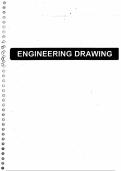
Copy of Engineering Drawing
Engineering drawings are graphical representations of objects, structures, or systems that are used in various fields of engineering, such as mechanical, civil, electrical, and architectural engineering. These drawings provide detailed information about the dimensions, shapes, and features of the object being represented. Here are some key aspects of engineering drawings: Types of Drawings: There are different types of engineering drawings, including: Orthographic Drawings: These show t...
- Interview
- • 56 pages •
Engineering drawings are graphical representations of objects, structures, or systems that are used in various fields of engineering, such as mechanical, civil, electrical, and architectural engineering. These drawings provide detailed information about the dimensions, shapes, and features of the object being represented. Here are some key aspects of engineering drawings: Types of Drawings: There are different types of engineering drawings, including: Orthographic Drawings: These show t...
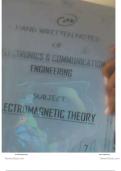
Electromagnatic Theory old2 294.pdf
Maxwell's Equations: James Clerk Maxwell formulated a set of four differential equations, known as Maxwell's equations, which describe the behaviour of electric and magnetic fields. These equations relate to electric field (E), magnetic field (B), electric charge, and electric current. Maxwell's equations provide a mathematical framework for understanding the generation, propagation, and interaction of electromagnetic waves. Coulomb's Law and Gauss's Law: Coulomb's Law describes the for...
- Interview
- • 294 pages •
Maxwell's Equations: James Clerk Maxwell formulated a set of four differential equations, known as Maxwell's equations, which describe the behaviour of electric and magnetic fields. These equations relate to electric field (E), magnetic field (B), electric charge, and electric current. Maxwell's equations provide a mathematical framework for understanding the generation, propagation, and interaction of electromagnetic waves. Coulomb's Law and Gauss's Law: Coulomb's Law describes the for...
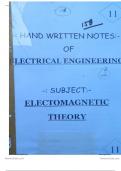
Electromagnatic Theroy old 156.pdf
Maxwell's Equations: James Clerk Maxwell formulated a set of four differential equations, known as Maxwell's equations, which describe the behaviour of electric and magnetic fields. These equations relate to electric field (E), magnetic field (B), electric charge, and electric current. Maxwell's equations provide a mathematical framework for understanding the generation, propagation, and interaction of electromagnetic waves. Coulomb's Law and Gauss's Law: Coulomb's Law describes the for...
- Interview
- • 156 pages •
Maxwell's Equations: James Clerk Maxwell formulated a set of four differential equations, known as Maxwell's equations, which describe the behaviour of electric and magnetic fields. These equations relate to electric field (E), magnetic field (B), electric charge, and electric current. Maxwell's equations provide a mathematical framework for understanding the generation, propagation, and interaction of electromagnetic waves. Coulomb's Law and Gauss's Law: Coulomb's Law describes the for...
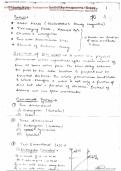
Electromagnetic Theory 158.pdf
Electromagnetic theory, also known as electromagnetism, is a branch of physics that explores the behavior and interaction of electric and magnetic fields. It provides a fundamental understanding of how electromagnetic phenomena occur and how they are described mathematically. Key concepts and principles in electromagnetic theory include: Maxwell's Equations: James Clerk Maxwell formulated a set of four differential equations, known as Maxwell's equations, which describe the behaviour of ...
- Interview
- • 158 pages •
Electromagnetic theory, also known as electromagnetism, is a branch of physics that explores the behavior and interaction of electric and magnetic fields. It provides a fundamental understanding of how electromagnetic phenomena occur and how they are described mathematically. Key concepts and principles in electromagnetic theory include: Maxwell's Equations: James Clerk Maxwell formulated a set of four differential equations, known as Maxwell's equations, which describe the behaviour of ...
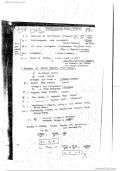
Electromagnetic theory 184.pdf
Ampere's Law and Faraday's Law: Ampere's law relates the magnetic field to electric currents and changing electric fields, while Faraday's law of electromagnetic induction explains how a changing magnetic field induces an electric field. These laws form the basis for understanding magnetic fields, electromagnetic induction, and the generation of electric currents. Electromagnetic Waves: Electromagnetic theory explains the generation, propagation, and behavior of electromagnetic waves. The...
- Interview
- • 184 pages •
Ampere's Law and Faraday's Law: Ampere's law relates the magnetic field to electric currents and changing electric fields, while Faraday's law of electromagnetic induction explains how a changing magnetic field induces an electric field. These laws form the basis for understanding magnetic fields, electromagnetic induction, and the generation of electric currents. Electromagnetic Waves: Electromagnetic theory explains the generation, propagation, and behavior of electromagnetic waves. The...
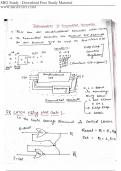
digital-electronics-5-sequential-circuit-notes.pdf
Number systems also provide a way to represent negative numbers in digital electronics. One common method is using the two's complement representation. In the two's complement system, the most significant bit (MSB) is used to indicate the sign of the number, with 0 representing a positive number and 1 representing a negative number. This representation allows for efficient addition and subtraction operations in digital circuits. In addition to the fundamental number systems, digital electro...
- Interview
- • 29 pages •
Number systems also provide a way to represent negative numbers in digital electronics. One common method is using the two's complement representation. In the two's complement system, the most significant bit (MSB) is used to indicate the sign of the number, with 0 representing a positive number and 1 representing a negative number. This representation allows for efficient addition and subtraction operations in digital circuits. In addition to the fundamental number systems, digital electro...

EMT 311.pdf
It is also crucial to practice a variety of problems from previous GATE exams and other relevant resources to develop problem-solving skills and to become familiar with the exam pattern. Solving numerical problems and applying theoretical concepts to real-world scenarios will help candidates gain confidence and improve their speed and accuracy. Moreover, candidates should familiarize themselves with the engineering mechanics software tools commonly used in the industry, such as MATLAB, ANSYS,...
- Interview
- • 310 pages •
It is also crucial to practice a variety of problems from previous GATE exams and other relevant resources to develop problem-solving skills and to become familiar with the exam pattern. Solving numerical problems and applying theoretical concepts to real-world scenarios will help candidates gain confidence and improve their speed and accuracy. Moreover, candidates should familiarize themselves with the engineering mechanics software tools commonly used in the industry, such as MATLAB, ANSYS,...

EMT nw 232.pdf
Understanding the fundamental concepts and principles is essential, as it forms the basis for solving complex engineering problems. Candidates should focus on topics like free body diagrams, resolving forces, moments, equilibrium conditions, and the application of Newton's laws of motion. Additionally, studying the concepts of work, energy, power, and impulse-momentum principles will further enhance problem-solving abilities. It is also crucial to practice a variety of problems from previous...
- Interview
- • 231 pages •
Understanding the fundamental concepts and principles is essential, as it forms the basis for solving complex engineering problems. Candidates should focus on topics like free body diagrams, resolving forces, moments, equilibrium conditions, and the application of Newton's laws of motion. Additionally, studying the concepts of work, energy, power, and impulse-momentum principles will further enhance problem-solving abilities. It is also crucial to practice a variety of problems from previous...

EMT P1 168.pdf
In the context of the Graduate Aptitude Test in Engineering (GATE), a highly competitive examination for admission into postgraduate engineering programs in India, having a thorough understanding of engineering mechanics is essential. The GATE exam often includes questions that test the candidates' knowledge of statics and dynamics concepts, their ability to apply those concepts to solve engineering problems, and their aptitude for engineering analysis. To prepare for the engineering mechani...
- Interview
- • 166 pages •
In the context of the Graduate Aptitude Test in Engineering (GATE), a highly competitive examination for admission into postgraduate engineering programs in India, having a thorough understanding of engineering mechanics is essential. The GATE exam often includes questions that test the candidates' knowledge of statics and dynamics concepts, their ability to apply those concepts to solve engineering problems, and their aptitude for engineering analysis. To prepare for the engineering mechani...

Electro Magnetic Fields Notes
Electromagnetic fields (EM fields) are physical fields generated by electric charges and currents. They are composed of both electric fields and magnetic fields, which are interconnected and influence each other. Here are some important concepts related to electromagnetic fields: Electric Field (E): The electric field is a vector field created by electric charges. It describes the force experienced by other charges in the presence of the electric field. The electric field is measured in vo...
- Interview
- • 78 pages •
Electromagnetic fields (EM fields) are physical fields generated by electric charges and currents. They are composed of both electric fields and magnetic fields, which are interconnected and influence each other. Here are some important concepts related to electromagnetic fields: Electric Field (E): The electric field is a vector field created by electric charges. It describes the force experienced by other charges in the presence of the electric field. The electric field is measured in vo...
